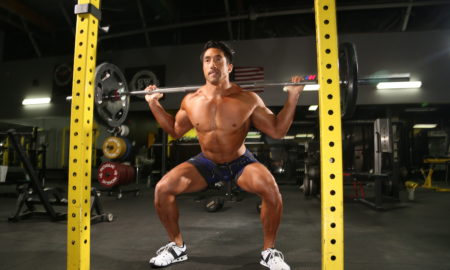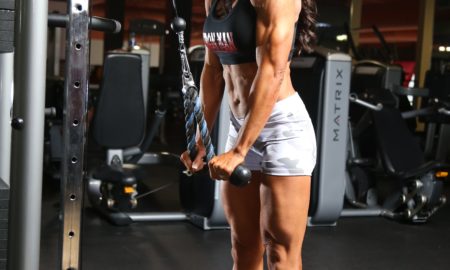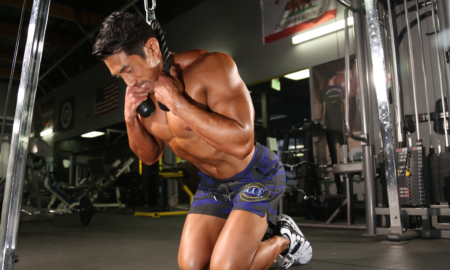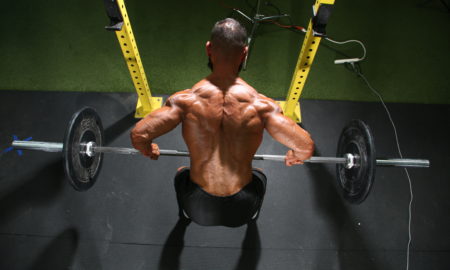The shrug is a fairly common exercise, an excellent movement for the development and strength of the trapezius group, or traps, particularly the upper trapezius, which is located on top of the shoulder. The shrug tends to lend itself to heavy weights, which can help most trainees. Some prefer the upright row, an exercise I’ve discussed many times that can be a harmful to the shoulder. The shrug is a much safer movement, but as with most exercises it carries risks.
The trapezius is a large, kite-shaped muscle of the back. It attaches from the base of the skull to the bottom of the midback and onto the scapula, or shoulder blade. The top of the trapezius is what most trainees refer to as traps; however, kinesiologists divide the traps into four sections. The upper trapezius has two sections, 1 and 2. Upper trapezius 1 is the most vertical part of the muscle, and 2 is more of the angled muscle fiber on top of the shoulder. The middle trapezius, 3, lies on top of the rhomboids. The lower trap, 4, is the bottom of the kite shape and attaches near the top of the lower back. The upper traps elevate the shoulders, as in a shrug movement, and upwardly rotate the shoulder blades, as in a military press. The middle and lower traps pull the shoulder blades back—a move called scapular retraction—as when you perform a dumbbell, barbell, T-bar or seated cable row.
Bodybuilders use the shrug for maximum upper-trap development, powerlifters use it to help with the completion of the deadlift, Olympic weightlifters use it to help accelerate the bar at the top of the pull, and trainees who simply wish to be strong and look strong use it as well.
The shrug presents two main problems. The first and most obvious is a shoulder injury that can occur when you’re in the middle of a heavy set. Many trainees try to find the strength to perform one more rep—they relax their arms and shoulders, take a deep breath and pull one more time. Trouble is, as soon as you relax the arms or shoulders, the weight being pulled down by gravity suddenly becomes a traction force on the shoulder; the ball is instantly pulled down in the socket. That sprains the ligaments in the shoulder and can strain the rotator cuff muscles. Both scenarios are bad. The solution is simple: Do not relax your arms and shoulders in the middle of a shrug—ever.
The second problem is difficult to predict. Some trainees can develop trapezius tendinitis. Tendons attach muscle to bone. The upper trapezius inserts into a bony ridge on the shoulder blade known as the spine of the scapula. If you feel your upper trapezius right now, you will feel the middle of the muscle belly. Follow the upper trapezius down along the backside of the body. You’ll feel bone within a few inches of moving your fingers down. That’s the spine of the scapula, and in the gym you’ll see some trainees reach to the spot to try to massage the soreness and tendinitis. The tendinitis may occur from heavy training, poor recovery from heavy training, poorly planned training programs—going too heavy too many times—as well as training heavy when already fatigued.
Former elite 275-pound-class powerlifter John Gamble used to perform shrugs with 700 pounds. One of the best bodybuilders of all time, Casey Viator, also did shrugs with 700 pounds—but at a much lower bodyweight. For a brief period of time Casey trained with Mike and Ray Menzter.
The Mentzers were known for their heavy training and low set volume—Heavy Duty. There’s always been misunderstanding regarding their training. Many trainees think the Mentzers performed one set of each exercise only. That’s simply not the case, and training with such heavy weight without a warmup will eventually lead to injury, perhaps sooner rather than later. Bill Bergman, Ph.D., of the Soft Tissue Center at D.I.S.C. in Marina del Rey, California, recalls his many training sessions with the Mentzers: “We performed the shrug, usually toward the end of the workout, when we were warmed up. We always performed two warmup sets and then two heavy sets. Mike and I had trap tendinitis, but Ray never complained about it. We’d sometimes take in a light workout for the shoulders consisting of supersetting laterals, presses and Nautilus shrugs. Mike’s shoulder tendinitis haunted him to the end.”
If the shrug has produced tendinitis for you, take a break for a few weeks. Lighten the weight and build back up again. Make sure you always warm up with a few progressive sets. Plan lighter training days for recovery. I’ll have more on that in the future.
Editor’s note: Visit www.SoftTissueCenter.com for reprints of Horrigan’s past Sportsmedicine columns that have appeared in IRON MAN. You can order the books Strength, Conditioning and Injury Prevention for Hockey by Joseph Horrigan, D.C., and E.J. “Doc” Kreis, D.A., and the 7-Minute Rotator Cuff Solution by Horrigan and Jerry Robinson from Home Gym Warehouse, (800) 447-0008, or at www.Home-Gym.com.




















You must be logged in to post a comment Login